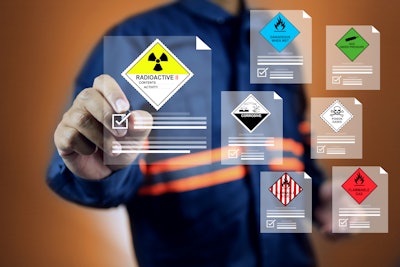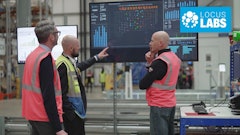
Don’t let the mundane nature of warehousing fool you — it can be a truly high-stakes part of daily supply chain operations. Especially when storing and handling dangerous goods (DG)/hazardous materials (hazmat).
Just look at the stats:
· Between 2021-2024, 102,177 hazardous chemical incidents occurred in the United States, resulting in damages exceeding a whopping $1 billion.
· Since 2018, there have been an average of 1,508 warehouse fires annually.
· Since 2022, New York City alone has experienced more than 800 fires because of lithium-ion batteries, leading to 30 deaths and more than 400 injuries.
Effectively warehousing DG needs more than just storage space – it requires an ecosystem where compliance, safety and efficiency work hand in hand.
Here’s the key components that contribute to a successful warehousing operation: facility design, regulatory compliance, employee training, and let's not forget safe handling and inspection processes to ensure safety.
1. The foundation of safe storage: Regulatory compliance
Proper classification, packing, labeling, and documentation are all required for warehousing any type of dangerous goods. And the definition of “dangerous goods” goes far beyond the obvious items and substances, such as explosives, corrosives, and radioactive materials. It also includes everyday products such as lithium-ion batteries, fuels, aerosols, cleaning solutions, paints, lighters, air bags, seatbelt tensioners and much more.
Shipping, handling, and storing any of these products could involve obtaining proper EPA certification, maintaining waste generator status (small vs. large), and following stringent rules for packaging, labeling, and documentation. Why? Because each material type has unique characteristics and risks. Batteries, for instance, may have additional requirements when over 50 kWh, while airbags and pretensioners are classified as UN3268 due to their explosive potential.
Once upon a time, batteries were just something we popped into flashlights or the TV remote. Now? Lithium-ion batteries are everywhere, including cell phones, laptops, power tools, e-bikes and more.
Local authorities can also impose additional rules, sometimes restricting storage beyond federal or state regulations. Some companies are limited to storing only three batteries at a time, even though the facility is fully certified and being properly outfitted to handle more.
To successfully store DG, your company needs to understand what DG parts are stored in addition to the rules and regulations for storing them. You then want to ensure that all these goods are properly packaged, labeled, and placarded so that anyone walking into the facility — even a new employee — can easily identify and handle them correctly. That way, when a product’s picked from the warehouse, it’s already set up to meet all the requirements for safe, compliant shipping out the door.
2. Facility design that matters: Storage safety and conditions
To put it simply, where, and how you store your stuff matters. The right warehousing design, protocols and safety measures don’t just prevent accidents — they give confidence that hazardous materials are always in capable hands. Here are some examples of design features to consider when it comes to choosing and equipping warehouses:
· Temperature control: Batteries and other DG parts need to be stored in a suitable environment suitable to help prevent degradation or other adverse events.
· Ventilation: Another big factor, particularly with EV batteries, is ensuring proper airflow. This helps dissipate off-gassing or chemical odors, protecting both your employees and your products.
· Segregation: Different product types must be stored in clearly designated areas. How you organize the warehouse space itself can have a big impact on ease of management.
· Security: The right security technology and protocols is essential, especially for high-value items. Cameras, alarms, and controlled access all help protect inventory and employees.
Some of the other tool and processes to consider when it comes to warehouse safety protocols include:
· Fire suppression systems, such as ESFR (early suppression fast response) sprinklers.
· Off-gas sensors, thermal cameras, and smoke detectors.
· Outdoor quarantine areas for batteries showing signs of thermal runaway.
· Personal protective equipment (PPE) for employees, such as voltage-rated gloves, jumpsuits, face shields, and non-conductive shoes.
· Working in pairs for high-risk tasks, so that someone is always available to help in the case of an emergency.
3. The right procedures in place: Handling and inspections
A key part of the warehousing process is how you handle and inspect the goods being warehoused and shipped from facilities and it can get more complicated.
As a result, here are three tried-and-true tips:
Tip 1: Make sure parts are moved safely throughout the facility using the right equipment. For example, if you’re loading a 3,000-pound battery using a 2,500-pound forklift, you’re going to have a problem. It’s something to always check for during site reviews and technical assessments for customers — everything on the floor must be up to spec.
Tip 2: Proper labeling and identification are more important than you think; every item in the supply chain must be labeled correctly, with the right chemistry type noted and placards applied properly. Don’t let the little things go unnoticed. Something as small as an oversized DG label wrapping over the edge of a box can trigger a fine, or even worse, supply chain delays that lead to unhappy customers.
Tip 3: A lot of companies want to set up battery charging capabilities inside the warehouse, but it can get costly, quickly. One company only needed a few chargers and thought it would only cost them $2,000. But once the specs came through, the quote came back over $35,000. It was an important reminder that even seemingly simple upgrades can have major cost implications when dealing with DG.
4. Employees you can trust: Training and personnel
A well-trained and confident workforce means safer warehouses and a more compliant and profitable company. Training is critical for all employees involved at each stage of warehousing and shipping DG. Training and re-training employees to use the proper technology, packaging and labeling goes a long way toward keeping everyone safe. Plus, it helps everyone know that safety is key to everyone’s success.
To build a knowledgeable workforce that takes ownership of safe practices, companies should focus on:
· Investing in employee training: DG warehousing and shipping can come with high pressure situations that require serious accountability. Regular education on regulations ensures compliance and builds confidence within teams, allowing them to shine.
· Developing the right DG leaders: Appointing a knowledgeable DG ambassador within your organization helps drive best practices and fosters an ongoing culture of compliance.
· Providing hands-on learning: Practical experience with modern DG tools and technologies helps teams stay ahead of regulatory changes and industry advancements. This also increases employee satisfaction and reduces overall stress, as employees will feel that they are properly equipped to understand shipping requirements.
A note on AI
Artificial intelligence (AI) is making waves, and DG shipping is no exception. But don’t expect AI to take over day-to-day compliance any time soon. Human judgment and situational awareness are big drivers to help reduce complexities of shipping DG. The risk is too high, and the variables are too complex.
Think of AI as decision support, not a replacement for human knowledge and the right automation tools. You can take advantage of automated suggestions for exemptions, real-time, shipment-specific rule validation, or flagging errors before they hit the warehouse floor. The goal isn’t to replace humans — it’s to spread expertise, catch mistakes early and scale good decisions across the entire supply chain.
Handling dangerous goods isn’t just about following the rules — it’s about knowing where to find the information to ensure regulatory compliance, that will help protect people, products and brand reputation.
When shipping DG, the details truly matter: the right label, the right forklift, the right temperature, and the right training. When everyone in the organization understands the “why” behind the process, safety becomes second nature. That’s when compliance stops feeling like a burden and starts feeling like an advantage.




















